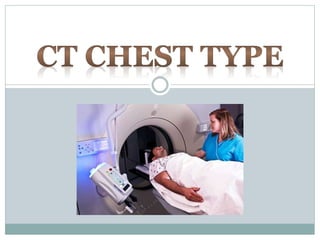Ct chest type
- 2. CT Types 1. Standard 2. High Resolution 3. Low Dose 4. CT Angio
- 3. Axial lung window Coronal C+ arterial phase Normal CT chest
- 4. STANDARD CT ïĄ Slice thickness: 3-10 mm ïĄ scans a large volume, very quickly ïĄ Covers the full lung ïĄ +/- contrast ïķIndications ïĄ CXR abnormality ïĄ Pleural and mediastinal abnormalities ïĄ Lung cancer staging ïĄ F/U metastases ïĄ Empyema vs abscess
- 6. HIGH RESOLUTION (HRCT) It is used in the diagnosis of various health problems, though most commonly for lung disease. It involves the use of special computed tomography scanning techniques to assess the lung parenchyma. STANDARD CT HRCT
- 7. HIGH RESOLUTION (HRCT) ï narrow x-ray beam collimation: 1-1.3mm vs. conventional 3-10mm ï cross sections are further apart: 10 mm ï high definition images of lung parenchyma: vessels, airspaces, airway and interstitium ï No contrast
- 8. HIGH RESOLUTION (HRCT) ïķ Indications ïĄ Hemoptysis ïĄ Diffusely abnormal CXR ïĄ Normal CXR with abnormal PFTâs ïĄ Baseline for pts with diffuse lung disease ïĄ Solitary pulmonary nodules ïĄ Reversible (active) vs. non-reversible (fibrotic) lung disease ïĄ Lung biopsy guide ïĄ F/U known lung disease ïĄ Assess Rx response
- 9. LOW DOSE
- 10. Baseline Findings - ELCAP ï According to ( Early Lung Cancer Action Program) ïķLow dose CT greatly increases the likelihood of detection of NCN and early lung cancer compared with chest radiography ïĄ NCN: 3 times as commonly ïĄ Malignant tumors: 4 times as commonly ïĄ Stage I tumors: 6 times as commonly
- 11. Low-dose CT: Lung cancer
- 12. LOW DOSE âĒ Premise: lower dose radiation will not reduce the diagnostic functionality of the scan (eg. 250 mAs âš 50 mAs) âĒ Detail is decreased ïķUses ïĄ Screening â ongoing trials ïķF/U â infections â post lung transplant â metastases
- 13. ANGIOGRAPHY (CTA) âĒ contrast injected into peripheral vein âĒ injection timing/rate controlled automatically âĒ dye is where you want it during scan âĒ replaced conventional catheter angiogram ïķ Indications ïĄ Pulmonary embolism ïĄ Aortic aneurysms ïĄ Aortic dissection ïķ Risks ïĄ Iodinated contrast: â Allergic/ nephrotoxic
- 14. 69- year old female with shortness of breath ANGIOGRAPHY (CTA)
- 15. CT pulmonary angiogram (CTPA) Example of a CTPA , demonstrating a saddle embolus. The white area above the center is the pulmonary artery, opacified by radiocontrast. Inside it, the grey matter is blood clot. The black areas on either side are the lungs, with around it the chest wall.
- 16. References 1. https://radiopaedia.org/cases/normal-ct-chest 2. http://www.slideshare.net/divitto1/approach-to-ct-chest-578 3. https://en.wikipedia.org/wiki/High-resolution_computed_tomography 4. http://slideplayer.com/slide/download/ 5. Henschke et al, Lancet 1999; 354:99-105 6. I-ELCAP is an international, collaborative group consisting of experts on lung cancer and related issues from around the world. ïž Made by; Abdullah Salem Al-habeeb
















